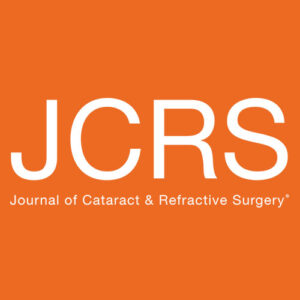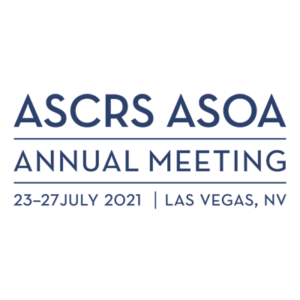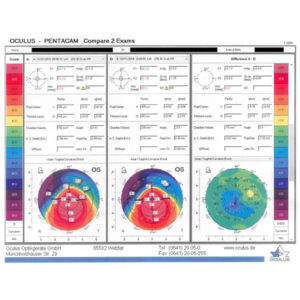ASCRS News
March 2021
by Liz Hillman
Editorial Co-Director

The ASCRS Master Class in Refractive Surgery, 20/Happy in 2020, will be available for purchase in the future as a nine-module digital set eligible for 18 hours of AMA PRA Category 1 Credits. Recordings will also remain available through the year for attendees who registered for the live program.
20/Happy began its rollout in August 2020 with a new module being released with live faculty discussion biweekly through December 2020. David Chang, MD, who guided development of the master class with co-director Kendall Donaldson, MD, described the accomplishment of the program. “For the first time, ASCRS has produced a comprehensive curriculum in refractive cataract surgery, which goes beyond the basics to help surgeons master patient evaluation, selection, education, and problem solving,” Dr. Chang said. “Eighty international faculty provided their expertise through a combination of lectures, interactive discussion, and audience Q&A. The content is organized and archived into nine separate modules so that surgeons can learn at their own pace and refer back to specific lectures and topics when needed.”
Each recorded module features expert presentations and panel discussion. Breakout rooms with live “ask the experts” questions from attendees were recorded and are available for viewers as well.
Ejaz Husain, MD, Des Moines, Iowa, attended the program and earned a certificate of completion. He described it as “a tremendous opportunity to learn about new advances and to learn from experts on how to improve and reinforce our practices with brilliant pearls of wisdom from the superb American and international faculty.”
“I think it provided comprehensive coverage of the issues we tackle within our practices every day, and it provided effective solutions to addressing patient problems,” Dr. Husain said.
Hitting the Refractive Target – Achieving 20/20 in 2020
Module 1 featured aspects that affect hitting the intended refractive target, including biometry, IOL calculations, surgical axis marking, intraoperative aberrometry, astigmatic keratometry, and managing residual refractive error.
Our Refractive IOL Armamentarium – More Choices Than Ever
In Module 2, physicians discussed the different IOL options available to U.S. surgeons, including toric IOLs, blended monofocal monovision, TECNIS Symfony EDOF IOL (Johnson & Johnson Vision), AcrySof IQ Vivity IOL (Alcon), PanOptix (Alcon), and the Light Adjustable Lens (RxSight). Optics and clinical performance of currently available IOLs were also featured.
Patient Evaluation and Selection – The Key to Refractive IOL Success
Module 3 offered tips for patient evaluation and selection, including obtaining lifestyle history, psychometrics and patient selection, corneal wavefront aberrometry, topography, role of the ocular surface, corneal issues, glaucoma, macular evaluation, and post-refractive challenges.
Patient Education and Counseling – Being Effective and Efficient
Module 4 addressed “a topic that we don’t speak enough about,” Dr. Chang said, “and that’s how to be really efficient and effective when we’re trying to do patient education and counseling.” Psychology of the refractive patient, preop consultation and education, presbyopia-correcting IOLs, explaining monovision vs. presbyopia-correcting IOLs, astigmatism correction, FLACS, informed consent, costs/value proposition, and the dissatisfied postop patient were discussed.
Office Management – The Premium IOL Practice
Module 5 showcased the various considerations that a premium refractive cataract practice has from a management perspective—preop planning and preparation, compliance and patient-shared billing, payment and financing, fees for enhancement, the Light Adjustable Lens, and your practice presence online.
Managing Complications and Patient Dissatisfaction – Taming Our Fears
Module 6 reviewed management of complications and patient dissatisfaction. Discussion covered the postop evaluation, communication pearls, toric IOL surprise, capsule complications, dysphotopsias, poor performance with diffractive IOLs, a decision tree, managing residual refractive error, and refractive IOL exchange pearls.
Adjunct Refractive Cataract Technology – What Do I Really Need?
Module 7 looked at technology like biometry, ocular surface diagnosis and treatment options, corneal evaluation technologies, FLACS, Zepto (Centricity Vision), operating microscopes, sustained-release drug delivery, and drop-free cataract surgery.
Real World Case Studies in Patient IOL Selection and Management
Module 8 featured case studies involving cataract surgery in the setting of post-LASIK ectasia, a miserable multifocal IOL patient, a keratoconic eye with apical corneal scar, phaco in an eye with a phakic IOL, discontentment with near vision after an EDOF IOL, issues with a presbyopia-correcting lens post-hyperopic LASIK, extruded haptic, and a former myope disappointed in loss of near vision.
What’s Ahead in 2021 and Beyond?
Topics in Module 9 included immediately sequential bilateral cataract surgery (ISBCS),
ISBCS and adjustable IOLs, EDOF IOLS (TECNIS Synergy and TECNIS Eyhance [Johnson & Johnson Vision]), the IC-8 small aperture IOL (AcuFocus), pharmacologic EDOF with miotic agents, trifocal and EDOF IOLs in the pipeline, an update on accommodating IOLs, refractive index shaping, and more.
In addition to the CME modules, 20/Happy featured non-CME, company-supported, online events that complimented what was learned in the CME program. The corporate modules are now viewable on demand and were supported by Alcon, Allergan, Bausch + Lomb, Carl Zeiss Meditec, Johnson & Johnson Vision, Novartis, Ocular Therapeutix, RxSight, Tarsus, and Tracey Technologies.
For more information about the program and access for current registrants, visit https://ascrs.org/20happy.



